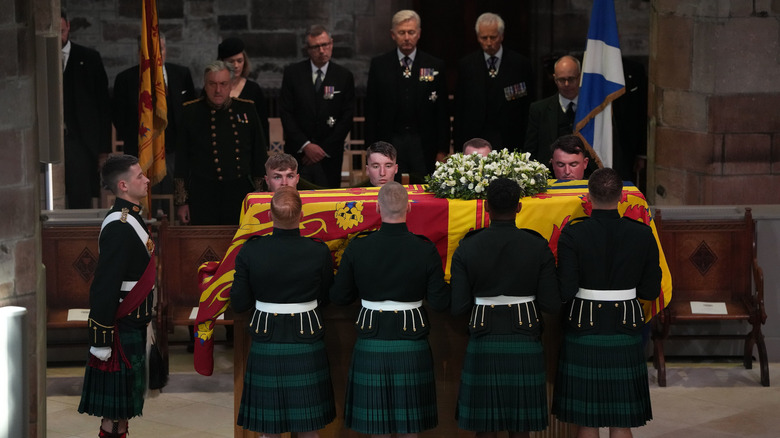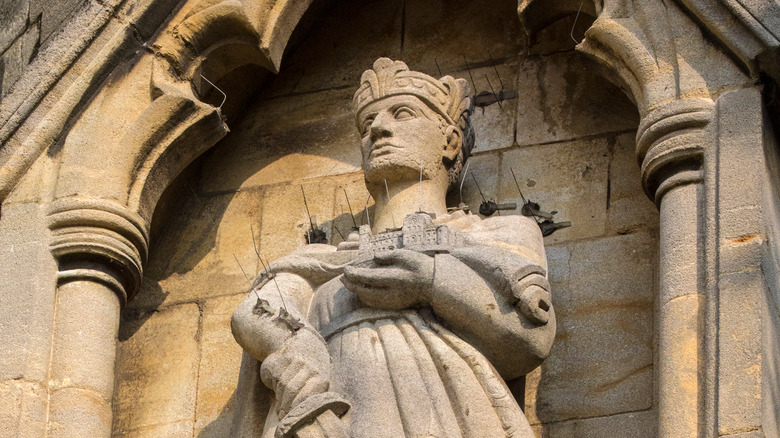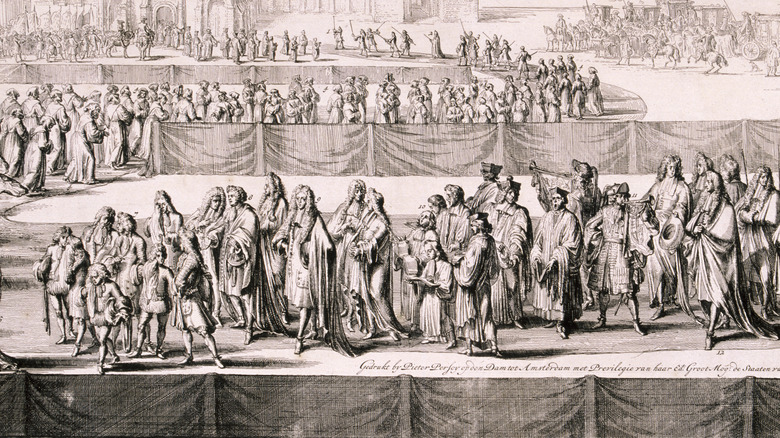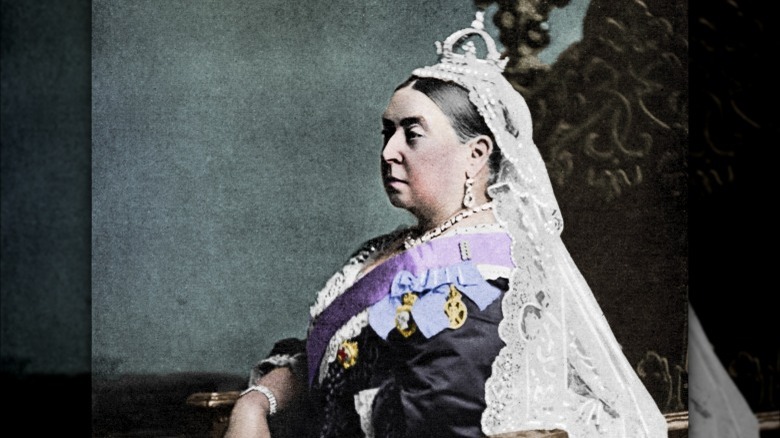Why Royals Never Have Open Caskets During Funerals
Before her scheduled funeral on Monday, September 19, Queen Elizabeth II's body will be lying-in-state so that mourners may pay their respects (via Bloomberg). Her closed coffin arrived at Westminster Hall at 5 p.m. on Wednesday, September 14, and will be accessible to the public 24 hours a day until 6:30 a.m. on the day of her funeral. The coffin is protected by highly-trained guards and draped in a royal flag with a crown placed on top. The sovereign's coffin was made 32 years ago out of English oak, which USA Today reports is a wood that is rarely used. The coffin is lined with lead so the body does not decay as quickly. The lead slows down the rate of decay and prevents odors from leaking out. This is especially important when placing a body in a burial vault instead of directly within the earth. This practice of lead-lined coffins originated in the Victorian era (via CTV News). However, the inside of the coffin is not for the public's viewing.
The historic event is expected to draw thousands of mourners to witness the traditions of saying farewell to a monarch. Media outlets and royal experts alike are speculating about the ways in which Queen Elizabeth's funeral service will lean into or deviate from British royal tradition. Undoubtedly, though, the coffin will be closed. While open casket funerals may be more common in the United States, Laurence Brown told Lost in the Pond that this isn't always the fashion in Great Britain, particularly when it comes to the royals.
Changes in English funerary customs over time
Funerary traditions have changed quite a bit in the United Kingdom since the death of the nation's last Anglo-Saxon monarch, King Harold II, in 1066 (via English Heritage). Harold died on the battlefield and is believed to have been so wounded in battle that only his wife could identify his remains (via The History Jar). William the Conquerer, who became king in December of that year, is said to have not wanted there to be a shrine to honor the fallen Harold and the exact location of his remains are still a mystery. Some speculate that only his heart was buried in Essex.
William the Conqueror claimed Christian control over the English lands that he invaded on behalf of Pope Alexander II (via Christianity.com). He died in Normandy, France, and while attempting a Christian burial of the king, it is said his funeral attendants botched the ceremony in the Abbey of Saint-Étienne (via Berkhamsted Castle). Apparently, his corpse exploded from an effort to shove his body into too small of a coffin, and the church was left with a pungent smell as a result. Historians believe this unfortunate turn of events allowed for looting and desecrating of the remains which might have led to stricter burial practices and/or guidelines (via Historic UK).
Extravagant affairs
Some 500 years later, when King Henry VIII died, England was now under the religious control of the newly-created Anglican Church. Yet, Henry VIII's funeral had all the pomp, circumstance, and iconography of a Catholic affair (via PhilippaGregory.com). It was a scene full of horses, incense smoke, and gleaming portraits of saints. Thousands of mourners, flanked by legions of royal horses, flocked to London for 10 days of funeral processions and the poor were compensated to pray for Henry's soul. Like Harold II, Henry VIII's corpse "exploded" and it is said that dogs licked up his bodily fluids. However, funerals of this magnitude continued well through Queen Mary II's death in the 17th century.
Queen Mary II's funeral in the spring of 1695 cost £50,000 (via Westminster Abbey). According to Eric W. Nye's Pounds Sterling to Dollars: Historical Conversion of Currency, over $11 million today. Mary died of smallpox at 32 but is said to have only a small rash on her chest and face (via TeamQueens.org). Artistic renderings of when the sovereign lying-in-state indicate that her casket was open. The public could view the queen in her purple and gold gown for a price during set hours each day. Diarist Evelyn observed (via TeamQueens.org), "The glamour and grandiosity of this funeral was yet another performance of a public identity, reflecting how the royal body is greater than the individual. Mary's life, and death, symbolised a nation in its social function. The cultivation of such a powerful image throughout her life was maybe why Mary was so widely and magnificently mourned, amongst a myriad of reasons, which included both personal attributes and public actions."
A picture is worth a thousand words
Until the death of Queen Elizabeth II, Queen Victoria was the longest reigning British monarch. During her reign, which was between 1837 and 1901, the rapidly-developing medium of photography would make her the most seen monarch of her time (via the J. Paul Getty Museum). The public had seen her in photographs since she was 20 years old. She and her husband, Prince Albert, shared a passion for photography which is perhaps why a photographer was allowed access to the monarch on her deathbed. The photo shows a framed picture of Prince Albert on his deathbed above her lacy bed (via National Portrait Gallery). According to British Heritage and Travel, Queen Victoria had 12 pages of explicit invectives for her funeral arrangements and casket, which were to include mementos. The Victorians in England were particularly influential with death photography that would carry over to the United States (via DailyHistory.org). After all, this was a means of preserving the memory of someone who died. According to the Order of the Good Death, this type of photography fell out of favor at the beginning of the 20th century.
While many Americans of various faiths believe an open casket is a similar way to provide closure and preserve a memory, the Anglican church instructions state: "The coffin is to be closed before the liturgy, and it remains closed thereafter. It is appropriate that it be covered with a funeral pall or other suitable covering." But the reason for Queen Elizabeth II's closed coffin may have more to do with the grim circumstances surrounding William the Conquerer and Henry VIII's funeral snafus.



